Leadership Styles Assignment PDF
VerifiedAdded on 2022/01/13
|7
|2524
|46
AI Summary
Contribute Materials
Your contribution can guide someone’s learning journey. Share your
documents today.

Student Name:
Student Number/FIN/NRIC:
Course Title:
Lecturer Name:
Submission Date:
1
Student Number/FIN/NRIC:
Course Title:
Lecturer Name:
Submission Date:
1
Secure Best Marks with AI Grader
Need help grading? Try our AI Grader for instant feedback on your assignments.

Table of Contents
Introduction …………………………………………………………………………………………… 3
Background ……………………………………………………………………………………. 3
Problem Statement …………………………………………………………………………… 3
Research ……………..………………………………………………………………………………… 3-5
Leadership Styles …………………………………………………………………………….. 3
6 Management Principles …………………………………………………………………… 4
Company Culture …………………………………………………………………………….. 5
Analysis ………………………………………………………………………………………………… 5-6
Conclusion …………………………………………………………………………………………….. 6
References ……………………………………………………………………………………………… 7
2
Introduction …………………………………………………………………………………………… 3
Background ……………………………………………………………………………………. 3
Problem Statement …………………………………………………………………………… 3
Research ……………..………………………………………………………………………………… 3-5
Leadership Styles …………………………………………………………………………….. 3
6 Management Principles …………………………………………………………………… 4
Company Culture …………………………………………………………………………….. 5
Analysis ………………………………………………………………………………………………… 5-6
Conclusion …………………………………………………………………………………………….. 6
References ……………………………………………………………………………………………… 7
2
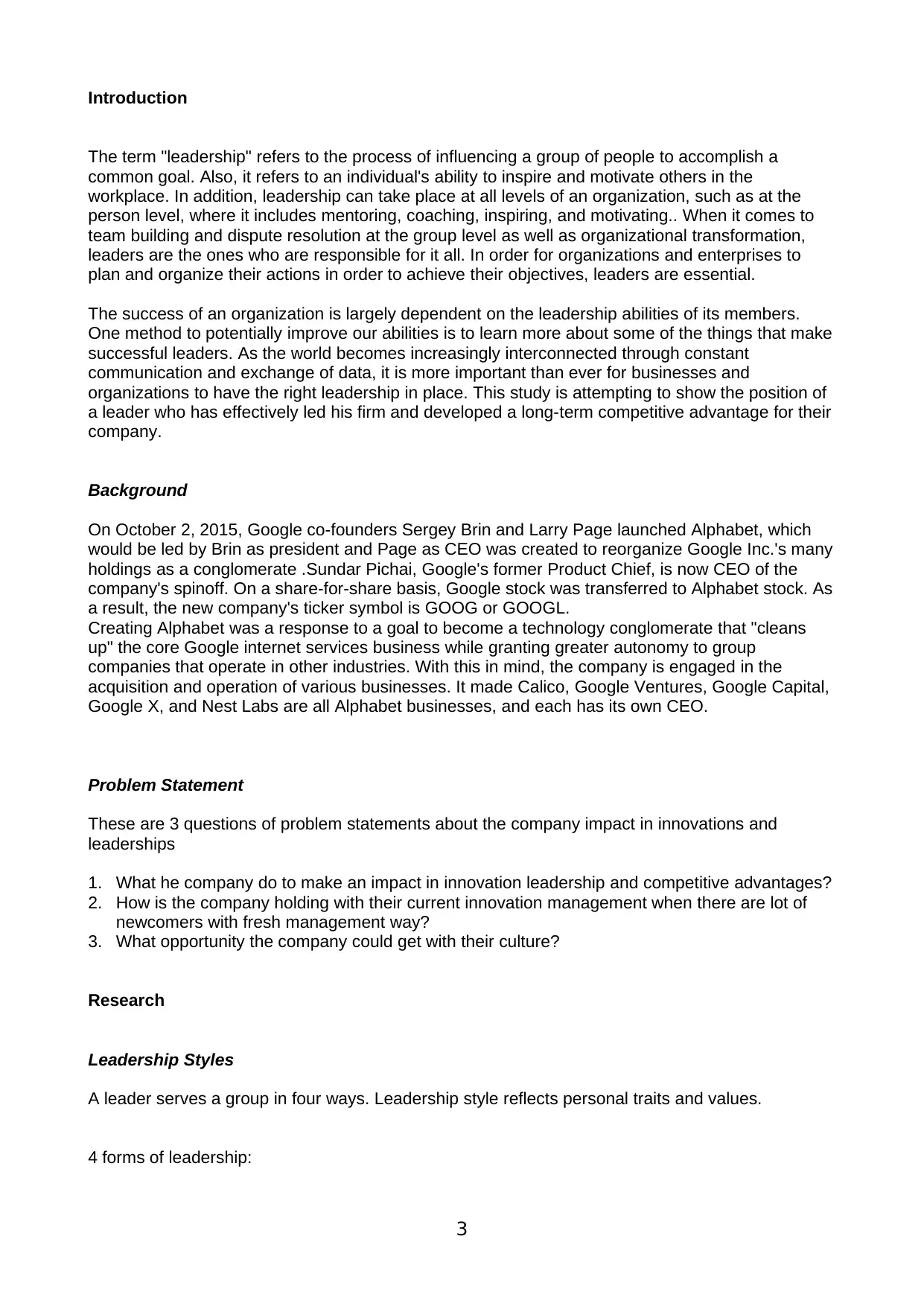
Introduction
The term "leadership" refers to the process of influencing a group of people to accomplish a
common goal. Also, it refers to an individual's ability to inspire and motivate others in the
workplace. In addition, leadership can take place at all levels of an organization, such as at the
person level, where it includes mentoring, coaching, inspiring, and motivating.. When it comes to
team building and dispute resolution at the group level as well as organizational transformation,
leaders are the ones who are responsible for it all. In order for organizations and enterprises to
plan and organize their actions in order to achieve their objectives, leaders are essential.
The success of an organization is largely dependent on the leadership abilities of its members.
One method to potentially improve our abilities is to learn more about some of the things that make
successful leaders. As the world becomes increasingly interconnected through constant
communication and exchange of data, it is more important than ever for businesses and
organizations to have the right leadership in place. This study is attempting to show the position of
a leader who has effectively led his firm and developed a long-term competitive advantage for their
company.
Background
On October 2, 2015, Google co-founders Sergey Brin and Larry Page launched Alphabet, which
would be led by Brin as president and Page as CEO was created to reorganize Google Inc.'s many
holdings as a conglomerate .Sundar Pichai, Google's former Product Chief, is now CEO of the
company's spinoff. On a share-for-share basis, Google stock was transferred to Alphabet stock. As
a result, the new company's ticker symbol is GOOG or GOOGL.
Creating Alphabet was a response to a goal to become a technology conglomerate that "cleans
up" the core Google internet services business while granting greater autonomy to group
companies that operate in other industries. With this in mind, the company is engaged in the
acquisition and operation of various businesses. It made Calico, Google Ventures, Google Capital,
Google X, and Nest Labs are all Alphabet businesses, and each has its own CEO.
Problem Statement
These are 3 questions of problem statements about the company impact in innovations and
leaderships
1. What he company do to make an impact in innovation leadership and competitive advantages?
2. How is the company holding with their current innovation management when there are lot of
newcomers with fresh management way?
3. What opportunity the company could get with their culture?
Research
Leadership Styles
A leader serves a group in four ways. Leadership style reflects personal traits and values.
4 forms of leadership:
3
The term "leadership" refers to the process of influencing a group of people to accomplish a
common goal. Also, it refers to an individual's ability to inspire and motivate others in the
workplace. In addition, leadership can take place at all levels of an organization, such as at the
person level, where it includes mentoring, coaching, inspiring, and motivating.. When it comes to
team building and dispute resolution at the group level as well as organizational transformation,
leaders are the ones who are responsible for it all. In order for organizations and enterprises to
plan and organize their actions in order to achieve their objectives, leaders are essential.
The success of an organization is largely dependent on the leadership abilities of its members.
One method to potentially improve our abilities is to learn more about some of the things that make
successful leaders. As the world becomes increasingly interconnected through constant
communication and exchange of data, it is more important than ever for businesses and
organizations to have the right leadership in place. This study is attempting to show the position of
a leader who has effectively led his firm and developed a long-term competitive advantage for their
company.
Background
On October 2, 2015, Google co-founders Sergey Brin and Larry Page launched Alphabet, which
would be led by Brin as president and Page as CEO was created to reorganize Google Inc.'s many
holdings as a conglomerate .Sundar Pichai, Google's former Product Chief, is now CEO of the
company's spinoff. On a share-for-share basis, Google stock was transferred to Alphabet stock. As
a result, the new company's ticker symbol is GOOG or GOOGL.
Creating Alphabet was a response to a goal to become a technology conglomerate that "cleans
up" the core Google internet services business while granting greater autonomy to group
companies that operate in other industries. With this in mind, the company is engaged in the
acquisition and operation of various businesses. It made Calico, Google Ventures, Google Capital,
Google X, and Nest Labs are all Alphabet businesses, and each has its own CEO.
Problem Statement
These are 3 questions of problem statements about the company impact in innovations and
leaderships
1. What he company do to make an impact in innovation leadership and competitive advantages?
2. How is the company holding with their current innovation management when there are lot of
newcomers with fresh management way?
3. What opportunity the company could get with their culture?
Research
Leadership Styles
A leader serves a group in four ways. Leadership style reflects personal traits and values.
4 forms of leadership:
3
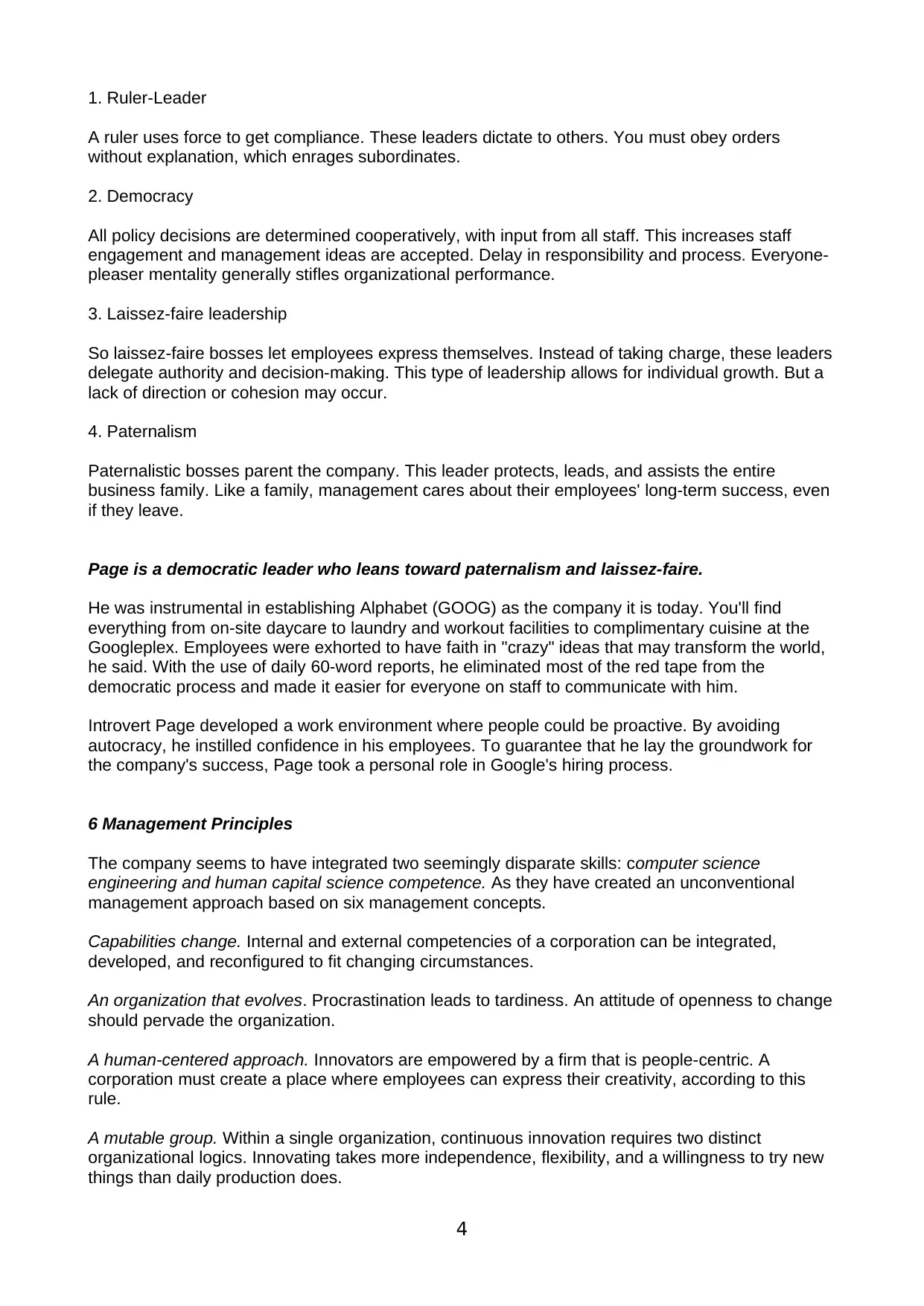
1. Ruler-Leader
A ruler uses force to get compliance. These leaders dictate to others. You must obey orders
without explanation, which enrages subordinates.
2. Democracy
All policy decisions are determined cooperatively, with input from all staff. This increases staff
engagement and management ideas are accepted. Delay in responsibility and process. Everyone-
pleaser mentality generally stifles organizational performance.
3. Laissez-faire leadership
So laissez-faire bosses let employees express themselves. Instead of taking charge, these leaders
delegate authority and decision-making. This type of leadership allows for individual growth. But a
lack of direction or cohesion may occur.
4. Paternalism
Paternalistic bosses parent the company. This leader protects, leads, and assists the entire
business family. Like a family, management cares about their employees' long-term success, even
if they leave.
Page is a democratic leader who leans toward paternalism and laissez-faire.
He was instrumental in establishing Alphabet (GOOG) as the company it is today. You'll find
everything from on-site daycare to laundry and workout facilities to complimentary cuisine at the
Googleplex. Employees were exhorted to have faith in "crazy" ideas that may transform the world,
he said. With the use of daily 60-word reports, he eliminated most of the red tape from the
democratic process and made it easier for everyone on staff to communicate with him.
Introvert Page developed a work environment where people could be proactive. By avoiding
autocracy, he instilled confidence in his employees. To guarantee that he lay the groundwork for
the company's success, Page took a personal role in Google's hiring process.
6 Management Principles
The company seems to have integrated two seemingly disparate skills: computer science
engineering and human capital science competence. As they have created an unconventional
management approach based on six management concepts.
Capabilities change. Internal and external competencies of a corporation can be integrated,
developed, and reconfigured to fit changing circumstances.
An organization that evolves. Procrastination leads to tardiness. An attitude of openness to change
should pervade the organization.
A human-centered approach. Innovators are empowered by a firm that is people-centric. A
corporation must create a place where employees can express their creativity, according to this
rule.
A mutable group. Within a single organization, continuous innovation requires two distinct
organizational logics. Innovating takes more independence, flexibility, and a willingness to try new
things than daily production does.
4
A ruler uses force to get compliance. These leaders dictate to others. You must obey orders
without explanation, which enrages subordinates.
2. Democracy
All policy decisions are determined cooperatively, with input from all staff. This increases staff
engagement and management ideas are accepted. Delay in responsibility and process. Everyone-
pleaser mentality generally stifles organizational performance.
3. Laissez-faire leadership
So laissez-faire bosses let employees express themselves. Instead of taking charge, these leaders
delegate authority and decision-making. This type of leadership allows for individual growth. But a
lack of direction or cohesion may occur.
4. Paternalism
Paternalistic bosses parent the company. This leader protects, leads, and assists the entire
business family. Like a family, management cares about their employees' long-term success, even
if they leave.
Page is a democratic leader who leans toward paternalism and laissez-faire.
He was instrumental in establishing Alphabet (GOOG) as the company it is today. You'll find
everything from on-site daycare to laundry and workout facilities to complimentary cuisine at the
Googleplex. Employees were exhorted to have faith in "crazy" ideas that may transform the world,
he said. With the use of daily 60-word reports, he eliminated most of the red tape from the
democratic process and made it easier for everyone on staff to communicate with him.
Introvert Page developed a work environment where people could be proactive. By avoiding
autocracy, he instilled confidence in his employees. To guarantee that he lay the groundwork for
the company's success, Page took a personal role in Google's hiring process.
6 Management Principles
The company seems to have integrated two seemingly disparate skills: computer science
engineering and human capital science competence. As they have created an unconventional
management approach based on six management concepts.
Capabilities change. Internal and external competencies of a corporation can be integrated,
developed, and reconfigured to fit changing circumstances.
An organization that evolves. Procrastination leads to tardiness. An attitude of openness to change
should pervade the organization.
A human-centered approach. Innovators are empowered by a firm that is people-centric. A
corporation must create a place where employees can express their creativity, according to this
rule.
A mutable group. Within a single organization, continuous innovation requires two distinct
organizational logics. Innovating takes more independence, flexibility, and a willingness to try new
things than daily production does.
4
Secure Best Marks with AI Grader
Need help grading? Try our AI Grader for instant feedback on your assignments.
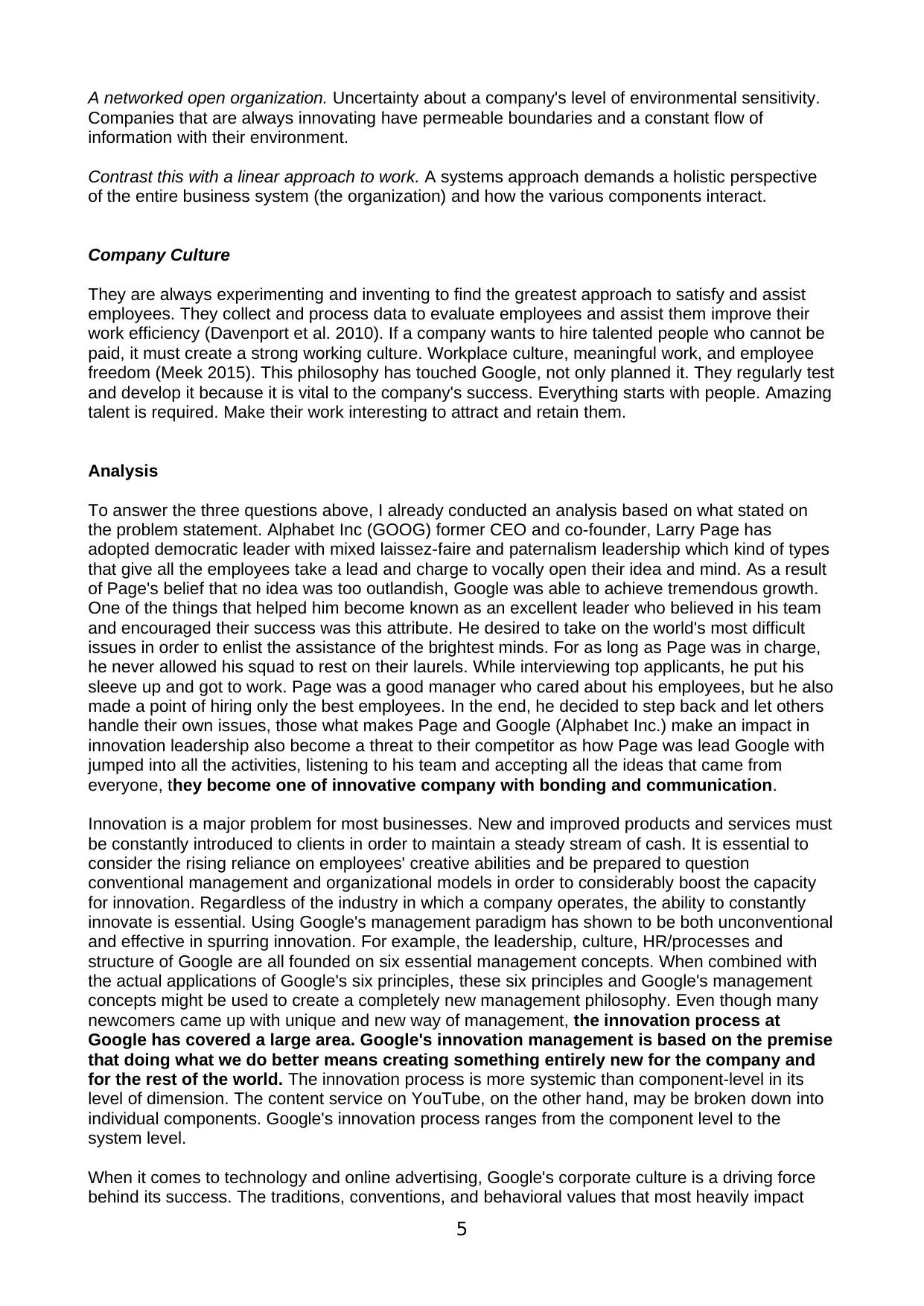
A networked open organization. Uncertainty about a company's level of environmental sensitivity.
Companies that are always innovating have permeable boundaries and a constant flow of
information with their environment.
Contrast this with a linear approach to work. A systems approach demands a holistic perspective
of the entire business system (the organization) and how the various components interact.
Company Culture
They are always experimenting and inventing to find the greatest approach to satisfy and assist
employees. They collect and process data to evaluate employees and assist them improve their
work efficiency (Davenport et al. 2010). If a company wants to hire talented people who cannot be
paid, it must create a strong working culture. Workplace culture, meaningful work, and employee
freedom (Meek 2015). This philosophy has touched Google, not only planned it. They regularly test
and develop it because it is vital to the company's success. Everything starts with people. Amazing
talent is required. Make their work interesting to attract and retain them.
Analysis
To answer the three questions above, I already conducted an analysis based on what stated on
the problem statement. Alphabet Inc (GOOG) former CEO and co-founder, Larry Page has
adopted democratic leader with mixed laissez-faire and paternalism leadership which kind of types
that give all the employees take a lead and charge to vocally open their idea and mind. As a result
of Page's belief that no idea was too outlandish, Google was able to achieve tremendous growth.
One of the things that helped him become known as an excellent leader who believed in his team
and encouraged their success was this attribute. He desired to take on the world's most difficult
issues in order to enlist the assistance of the brightest minds. For as long as Page was in charge,
he never allowed his squad to rest on their laurels. While interviewing top applicants, he put his
sleeve up and got to work. Page was a good manager who cared about his employees, but he also
made a point of hiring only the best employees. In the end, he decided to step back and let others
handle their own issues, those what makes Page and Google (Alphabet Inc.) make an impact in
innovation leadership also become a threat to their competitor as how Page was lead Google with
jumped into all the activities, listening to his team and accepting all the ideas that came from
everyone, they become one of innovative company with bonding and communication.
Innovation is a major problem for most businesses. New and improved products and services must
be constantly introduced to clients in order to maintain a steady stream of cash. It is essential to
consider the rising reliance on employees' creative abilities and be prepared to question
conventional management and organizational models in order to considerably boost the capacity
for innovation. Regardless of the industry in which a company operates, the ability to constantly
innovate is essential. Using Google's management paradigm has shown to be both unconventional
and effective in spurring innovation. For example, the leadership, culture, HR/processes and
structure of Google are all founded on six essential management concepts. When combined with
the actual applications of Google's six principles, these six principles and Google's management
concepts might be used to create a completely new management philosophy. Even though many
newcomers came up with unique and new way of management, the innovation process at
Google has covered a large area. Google's innovation management is based on the premise
that doing what we do better means creating something entirely new for the company and
for the rest of the world. The innovation process is more systemic than component-level in its
level of dimension. The content service on YouTube, on the other hand, may be broken down into
individual components. Google's innovation process ranges from the component level to the
system level.
When it comes to technology and online advertising, Google's corporate culture is a driving force
behind its success. The traditions, conventions, and behavioral values that most heavily impact
5
Companies that are always innovating have permeable boundaries and a constant flow of
information with their environment.
Contrast this with a linear approach to work. A systems approach demands a holistic perspective
of the entire business system (the organization) and how the various components interact.
Company Culture
They are always experimenting and inventing to find the greatest approach to satisfy and assist
employees. They collect and process data to evaluate employees and assist them improve their
work efficiency (Davenport et al. 2010). If a company wants to hire talented people who cannot be
paid, it must create a strong working culture. Workplace culture, meaningful work, and employee
freedom (Meek 2015). This philosophy has touched Google, not only planned it. They regularly test
and develop it because it is vital to the company's success. Everything starts with people. Amazing
talent is required. Make their work interesting to attract and retain them.
Analysis
To answer the three questions above, I already conducted an analysis based on what stated on
the problem statement. Alphabet Inc (GOOG) former CEO and co-founder, Larry Page has
adopted democratic leader with mixed laissez-faire and paternalism leadership which kind of types
that give all the employees take a lead and charge to vocally open their idea and mind. As a result
of Page's belief that no idea was too outlandish, Google was able to achieve tremendous growth.
One of the things that helped him become known as an excellent leader who believed in his team
and encouraged their success was this attribute. He desired to take on the world's most difficult
issues in order to enlist the assistance of the brightest minds. For as long as Page was in charge,
he never allowed his squad to rest on their laurels. While interviewing top applicants, he put his
sleeve up and got to work. Page was a good manager who cared about his employees, but he also
made a point of hiring only the best employees. In the end, he decided to step back and let others
handle their own issues, those what makes Page and Google (Alphabet Inc.) make an impact in
innovation leadership also become a threat to their competitor as how Page was lead Google with
jumped into all the activities, listening to his team and accepting all the ideas that came from
everyone, they become one of innovative company with bonding and communication.
Innovation is a major problem for most businesses. New and improved products and services must
be constantly introduced to clients in order to maintain a steady stream of cash. It is essential to
consider the rising reliance on employees' creative abilities and be prepared to question
conventional management and organizational models in order to considerably boost the capacity
for innovation. Regardless of the industry in which a company operates, the ability to constantly
innovate is essential. Using Google's management paradigm has shown to be both unconventional
and effective in spurring innovation. For example, the leadership, culture, HR/processes and
structure of Google are all founded on six essential management concepts. When combined with
the actual applications of Google's six principles, these six principles and Google's management
concepts might be used to create a completely new management philosophy. Even though many
newcomers came up with unique and new way of management, the innovation process at
Google has covered a large area. Google's innovation management is based on the premise
that doing what we do better means creating something entirely new for the company and
for the rest of the world. The innovation process is more systemic than component-level in its
level of dimension. The content service on YouTube, on the other hand, may be broken down into
individual components. Google's innovation process ranges from the component level to the
system level.
When it comes to technology and online advertising, Google's corporate culture is a driving force
behind its success. The traditions, conventions, and behavioral values that most heavily impact
5
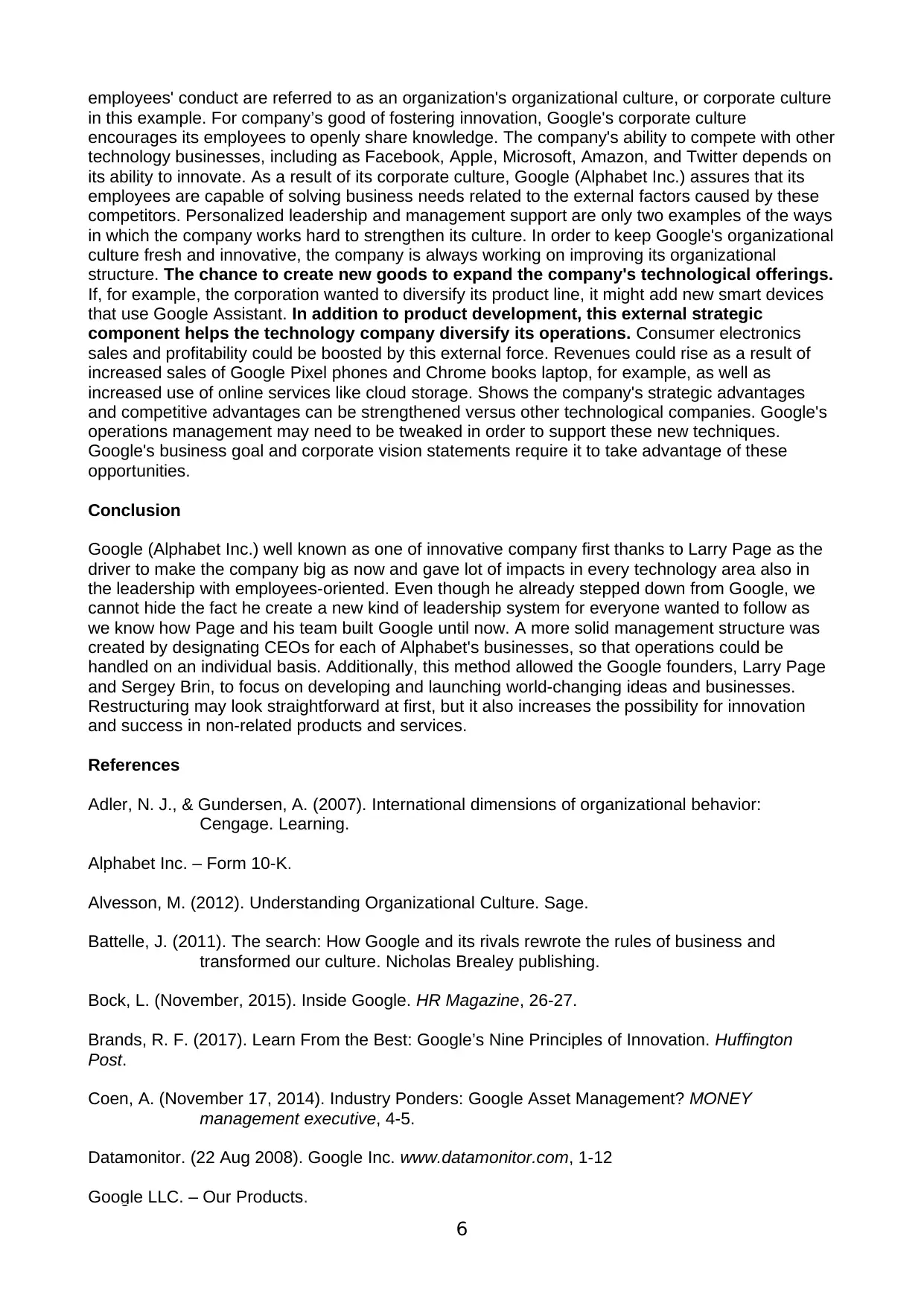
employees' conduct are referred to as an organization's organizational culture, or corporate culture
in this example. For company’s good of fostering innovation, Google's corporate culture
encourages its employees to openly share knowledge. The company's ability to compete with other
technology businesses, including as Facebook, Apple, Microsoft, Amazon, and Twitter depends on
its ability to innovate. As a result of its corporate culture, Google (Alphabet Inc.) assures that its
employees are capable of solving business needs related to the external factors caused by these
competitors. Personalized leadership and management support are only two examples of the ways
in which the company works hard to strengthen its culture. In order to keep Google's organizational
culture fresh and innovative, the company is always working on improving its organizational
structure. The chance to create new goods to expand the company's technological offerings.
If, for example, the corporation wanted to diversify its product line, it might add new smart devices
that use Google Assistant. In addition to product development, this external strategic
component helps the technology company diversify its operations. Consumer electronics
sales and profitability could be boosted by this external force. Revenues could rise as a result of
increased sales of Google Pixel phones and Chrome books laptop, for example, as well as
increased use of online services like cloud storage. Shows the company's strategic advantages
and competitive advantages can be strengthened versus other technological companies. Google's
operations management may need to be tweaked in order to support these new techniques.
Google's business goal and corporate vision statements require it to take advantage of these
opportunities.
Conclusion
Google (Alphabet Inc.) well known as one of innovative company first thanks to Larry Page as the
driver to make the company big as now and gave lot of impacts in every technology area also in
the leadership with employees-oriented. Even though he already stepped down from Google, we
cannot hide the fact he create a new kind of leadership system for everyone wanted to follow as
we know how Page and his team built Google until now. A more solid management structure was
created by designating CEOs for each of Alphabet's businesses, so that operations could be
handled on an individual basis. Additionally, this method allowed the Google founders, Larry Page
and Sergey Brin, to focus on developing and launching world-changing ideas and businesses.
Restructuring may look straightforward at first, but it also increases the possibility for innovation
and success in non-related products and services.
References
Adler, N. J., & Gundersen, A. (2007). International dimensions of organizational behavior:
Cengage. Learning.
Alphabet Inc. – Form 10-K.
Alvesson, M. (2012). Understanding Organizational Culture. Sage.
Battelle, J. (2011). The search: How Google and its rivals rewrote the rules of business and
transformed our culture. Nicholas Brealey publishing.
Bock, L. (November, 2015). Inside Google. HR Magazine, 26-27.
Brands, R. F. (2017). Learn From the Best: Google’s Nine Principles of Innovation. Huffington
Post.
Coen, A. (November 17, 2014). Industry Ponders: Google Asset Management? MONEY
management executive, 4-5.
Datamonitor. (22 Aug 2008). Google Inc. www.datamonitor.com, 1-12
Google LLC. – Our Products.
6
in this example. For company’s good of fostering innovation, Google's corporate culture
encourages its employees to openly share knowledge. The company's ability to compete with other
technology businesses, including as Facebook, Apple, Microsoft, Amazon, and Twitter depends on
its ability to innovate. As a result of its corporate culture, Google (Alphabet Inc.) assures that its
employees are capable of solving business needs related to the external factors caused by these
competitors. Personalized leadership and management support are only two examples of the ways
in which the company works hard to strengthen its culture. In order to keep Google's organizational
culture fresh and innovative, the company is always working on improving its organizational
structure. The chance to create new goods to expand the company's technological offerings.
If, for example, the corporation wanted to diversify its product line, it might add new smart devices
that use Google Assistant. In addition to product development, this external strategic
component helps the technology company diversify its operations. Consumer electronics
sales and profitability could be boosted by this external force. Revenues could rise as a result of
increased sales of Google Pixel phones and Chrome books laptop, for example, as well as
increased use of online services like cloud storage. Shows the company's strategic advantages
and competitive advantages can be strengthened versus other technological companies. Google's
operations management may need to be tweaked in order to support these new techniques.
Google's business goal and corporate vision statements require it to take advantage of these
opportunities.
Conclusion
Google (Alphabet Inc.) well known as one of innovative company first thanks to Larry Page as the
driver to make the company big as now and gave lot of impacts in every technology area also in
the leadership with employees-oriented. Even though he already stepped down from Google, we
cannot hide the fact he create a new kind of leadership system for everyone wanted to follow as
we know how Page and his team built Google until now. A more solid management structure was
created by designating CEOs for each of Alphabet's businesses, so that operations could be
handled on an individual basis. Additionally, this method allowed the Google founders, Larry Page
and Sergey Brin, to focus on developing and launching world-changing ideas and businesses.
Restructuring may look straightforward at first, but it also increases the possibility for innovation
and success in non-related products and services.
References
Adler, N. J., & Gundersen, A. (2007). International dimensions of organizational behavior:
Cengage. Learning.
Alphabet Inc. – Form 10-K.
Alvesson, M. (2012). Understanding Organizational Culture. Sage.
Battelle, J. (2011). The search: How Google and its rivals rewrote the rules of business and
transformed our culture. Nicholas Brealey publishing.
Bock, L. (November, 2015). Inside Google. HR Magazine, 26-27.
Brands, R. F. (2017). Learn From the Best: Google’s Nine Principles of Innovation. Huffington
Post.
Coen, A. (November 17, 2014). Industry Ponders: Google Asset Management? MONEY
management executive, 4-5.
Datamonitor. (22 Aug 2008). Google Inc. www.datamonitor.com, 1-12
Google LLC. – Our Products.
6
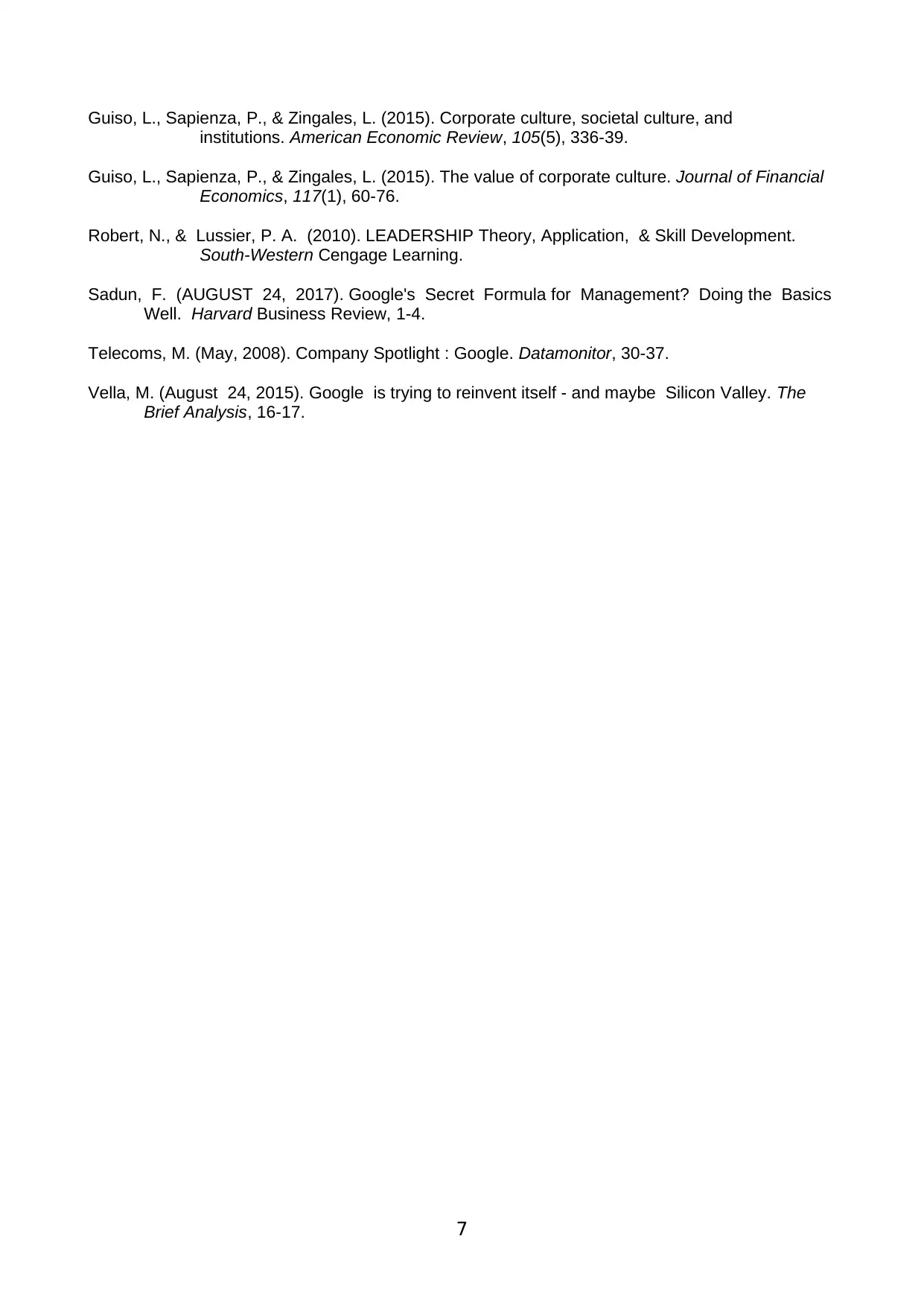
Guiso, L., Sapienza, P., & Zingales, L. (2015). Corporate culture, societal culture, and
institutions. American Economic Review, 105(5), 336-39.
Guiso, L., Sapienza, P., & Zingales, L. (2015). The value of corporate culture. Journal of Financial
Economics, 117(1), 60-76.
Robert, N., & Lussier, P. A. (2010). LEADERSHIP Theory, Application, & Skill Development.
South-Western Cengage Learning.
Sadun, F. (AUGUST 24, 2017). Google's Secret Formula for Management? Doing the Basics
Well. Harvard Business Review, 1-4.
Telecoms, M. (May, 2008). Company Spotlight : Google. Datamonitor, 30-37.
Vella, M. (August 24, 2015). Google is trying to reinvent itself - and maybe Silicon Valley. The
Brief Analysis, 16-17.
7
institutions. American Economic Review, 105(5), 336-39.
Guiso, L., Sapienza, P., & Zingales, L. (2015). The value of corporate culture. Journal of Financial
Economics, 117(1), 60-76.
Robert, N., & Lussier, P. A. (2010). LEADERSHIP Theory, Application, & Skill Development.
South-Western Cengage Learning.
Sadun, F. (AUGUST 24, 2017). Google's Secret Formula for Management? Doing the Basics
Well. Harvard Business Review, 1-4.
Telecoms, M. (May, 2008). Company Spotlight : Google. Datamonitor, 30-37.
Vella, M. (August 24, 2015). Google is trying to reinvent itself - and maybe Silicon Valley. The
Brief Analysis, 16-17.
7
1 out of 7
Related Documents
Your All-in-One AI-Powered Toolkit for Academic Success.
+13062052269
info@desklib.com
Available 24*7 on WhatsApp / Email
![[object Object]](/_next/static/media/star-bottom.7253800d.svg)
Unlock your academic potential
© 2024 | Zucol Services PVT LTD | All rights reserved.





